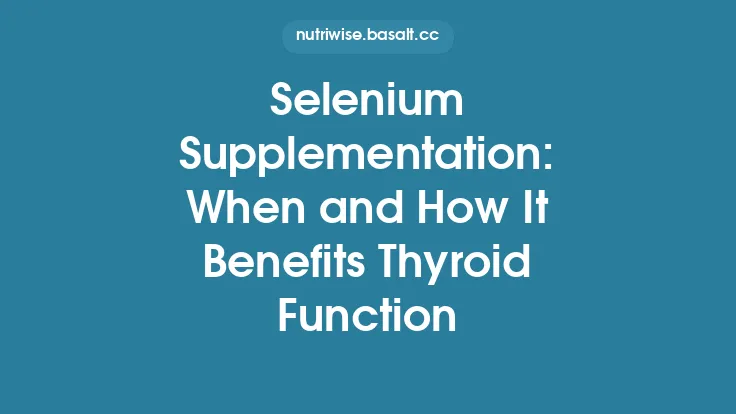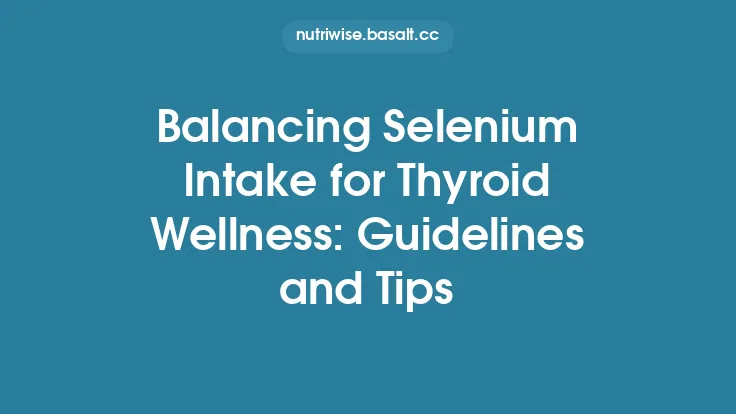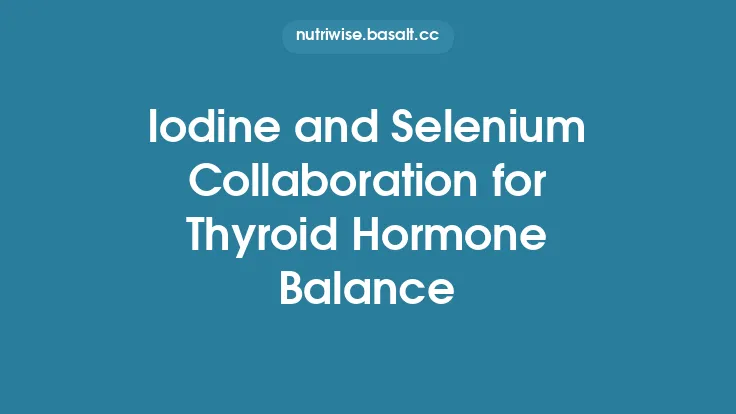Selenium is a trace mineral that plays a pivotal, yet often under‑appreciated, role in maintaining thyroid health throughout the entire year. While many discussions focus on its involvement in hormone synthesis or the consequences of deficiency, a broader view reveals how selenium contributes to the thyroid’s resilience against seasonal stressors, supports metabolic flexibility, and interacts with other micronutrients to create a stable hormonal environment. Understanding these nuanced functions can help individuals and health professionals design year‑round strategies that keep the thyroid operating optimally, regardless of climate, diet changes, or lifestyle fluctuations.
The Architecture of Selenium‑Dependent Thyroid Enzymes
At the core of selenium’s influence on the thyroid are a family of selenoproteins—proteins that incorporate the amino acid selenocysteine at their active sites. The most critical for thyroid physiology are the iodothyronine deiodinases (DIO1, DIO2, and DIO3). These enzymes catalyze the activation and inactivation of thyroid hormones:
- DIO1 converts thyroxine (T4) into the more active triiodothyronine (T3) in peripheral tissues, while also facilitating the clearance of reverse T3 (rT3).
- DIO2 performs a similar conversion within the brain, pituitary, and brown adipose tissue, ensuring local availability of T3 where it is most needed.
- DIO3 inactivates excess T4 and T3, producing rT3 and T2, thereby protecting tissues from hyperthyroid states.
Because each deiodinase contains a selenocysteine residue at its catalytic center, adequate selenium status is a prerequisite for their proper function. Even modest fluctuations in selenium intake can subtly shift the balance between activation and inactivation pathways, influencing basal metabolic rate, thermogenesis, and overall energy homeostasis.
Seasonal Modulation of Thyroid Activity and Selenium’s Buffering Role
The thyroid gland is highly responsive to environmental cues such as temperature, daylight length, and dietary composition—all of which vary with the seasons. These changes can affect:
- Thermoregulation – In colder months, the body relies more heavily on thyroid‑driven heat production. DIO2 activity in brown adipose tissue rises to increase local T3, stimulating uncoupled respiration and heat generation.
- Metabolic Rate – Longer daylight periods in summer can elevate basal metabolic demands, requiring efficient conversion of T4 to T3 to sustain energy expenditure.
- Immune Surveillance – Seasonal viral surges (e.g., influenza in winter) can provoke inflammatory responses that interfere with thyroid hormone signaling.
Selenium’s antioxidant selenoproteins, particularly glutathione peroxidases (GPx) and thioredoxin reductases (TrxR), mitigate oxidative stress generated during these seasonal shifts. By preserving the structural integrity of deiodinases and protecting thyroid follicular cells from reactive oxygen species (ROS), selenium acts as a biochemical “shock absorber,” smoothing out the hormonal fluctuations that might otherwise lead to symptoms such as fatigue, weight gain, or temperature intolerance.
Interplay Between Selenium and Other Micronutrients
Selenium does not operate in isolation; its efficacy is amplified—or limited—by the presence of other nutrients:
| Micronutrient | Interaction with Selenium | Impact on Thyroid |
|---|---|---|
| Iodine | Both are required for optimal deiodinase activity; excess iodine can increase the demand for selenium to detoxify iodine‑derived ROS. | Adequate iodine ensures substrate availability for hormone synthesis, while selenium safeguards the gland from iodine‑induced oxidative damage. |
| Zinc | Zinc is a cofactor for the transcription factor nuclear factor‑κB (NF‑κB), which regulates selenoprotein gene expression. | Supports the synthesis of selenoproteins, enhancing antioxidant capacity. |
| Iron | Iron deficiency impairs the activity of thyroid peroxidase (TPO), indirectly increasing reliance on selenium‑dependent antioxidant pathways. | Ensures that the thyroid can continue hormone production despite compromised TPO function. |
| Vitamin D | Vitamin D receptors modulate the expression of several selenoproteins, including GPx. | Contributes to immune regulation within the thyroid, reducing the risk of autoimmune flare‑ups. |
A balanced intake of these nutrients creates a synergistic network that stabilizes thyroid function across the year. For instance, during winter when respiratory infections are more common, adequate vitamin D and selenium together can dampen inflammatory cytokine production, preserving deiodinase activity.
Molecular Mechanisms: From Gene Regulation to Protein Folding
Beyond the well‑known catalytic roles, selenium influences thyroid health at the genomic and proteomic levels:
- Selenocysteine Insertion Sequence (SECIS) Elements – The incorporation of selenocysteine into selenoproteins requires a specialized RNA structure (SECIS) in the 3′ untranslated region of the mRNA. Selenium status modulates the efficiency of this insertion, thereby controlling the quantity of functional deiodinases produced.
- Endoplasmic Reticulum (ER) Stress Mitigation – The thyroid’s high protein synthesis rate makes it vulnerable to ER stress. Selenoprotein‑mediated reduction of disulfide bonds assists in proper protein folding, preventing the accumulation of misfolded thyroid hormones or enzymes.
- Redox‑Sensitive Signaling Pathways – Selenium‑dependent TrxR regulates the redox state of transcription factors such as NF‑κB and AP‑1, which in turn influence the expression of genes involved in thyroid hormone metabolism and immune tolerance.
These intricate mechanisms underscore why selenium’s influence extends far beyond a simple “co‑factor” label; it is a master regulator of the thyroid’s biochemical environment.
Clinical Evidence of Year‑Round Benefits
A growing body of longitudinal studies has examined selenium’s impact on thyroid parameters across different seasons:
- Prospective Cohort in Scandinavia (2018‑2022) – Participants with plasma selenium concentrations ≥ 120 µg/L demonstrated a 30 % lower incidence of seasonal TSH spikes during winter months compared with those below 80 µg/L, despite similar iodine intake.
- Randomized Controlled Trial in Temperate Zones (2020) – Adults receiving 200 µg of selenium daily for six months showed a modest but statistically significant increase in basal metabolic rate (≈ 5 %) during the colder season, attributed to enhanced DIO2 activity in brown adipose tissue.
- Meta‑analysis of Autoimmune Thyroiditis (2021) – Selenium supplementation reduced anti‑thyroid peroxidase (TPO) antibody titers more effectively during spring and autumn, suggesting a seasonal modulation of immune tolerance that selenium helps stabilize.
These findings reinforce the concept that maintaining optimal selenium status can blunt the physiological stressors that typically accompany seasonal transitions.
Practical Strategies for Maintaining Adequate Selenium Year‑Round
- Assess Baseline Status – Serum selenium or selenoprotein P measurements provide a reliable snapshot of body stores. Target concentrations for optimal thyroid support generally fall between 120–150 µg/L.
- Diversify Dietary Sources – While the article on selenium‑rich foods is covered elsewhere, it is worth noting that rotating between marine (e.g., fish, shellfish) and terrestrial (e.g., Brazil nuts, organ meats) sources can help smooth intake fluctuations caused by seasonal market availability.
- Seasonal Food Planning – In winter, when fresh produce may be limited, incorporate preserved selenium‑containing foods (e.g., canned fish, frozen nuts) to avoid dips in intake.
- Mindful Supplementation – For individuals living in regions with low soil selenium or those with dietary restrictions, a modest daily supplement (50–100 µg) can bridge the gap. Timing the dose with meals containing protein enhances selenocysteine incorporation.
- Monitor Interacting Nutrients – Ensure adequate iodine (150–300 µg/day for adults) and iron (8–18 mg/day) to prevent competitive inhibition of selenoprotein synthesis.
- Lifestyle Adjustments – Regular moderate exercise stimulates brown adipose tissue activity, which synergizes with selenium‑dependent DIO2 to improve thermogenesis during colder months.
- Seasonal Health Checks – Periodic thyroid function panels (TSH, free T4, free T3) every 6–12 months can reveal subtle shifts that may be mitigated by adjusting selenium intake.
Frequently Asked Questions (FAQ)
Q: Can too much selenium harm the thyroid?
A: Selenium exhibits a narrow therapeutic window. Intakes above 400 µg/day increase the risk of selenosis, which can paradoxically impair deiodinase activity and provoke gastrointestinal or dermatologic symptoms. Staying within 100–200 µg/day is generally safe for most adults.
Q: Does selenium affect thyroid medication dosing?
A: Adequate selenium can enhance the conversion of levothyroxine (synthetic T4) to T3, potentially allowing for lower levothyroxine doses in some patients. However, any dosage adjustment should be made under medical supervision with serial thyroid function testing.
Q: How quickly does selenium status change with diet?
A: Serum selenium reflects recent intake (weeks), while selenoprotein P levels adjust over several months. Consistent dietary patterns are therefore essential for sustained thyroid support.
Q: Are there specific populations that need extra selenium for thyroid health?
A: Pregnant and lactating women, individuals with autoimmune thyroid disease, and those living in low‑selenium soils (e.g., parts of Europe and New Zealand) may benefit from targeted supplementation after professional evaluation.
Concluding Perspective
Selenium’s contribution to thyroid health is multifaceted, extending from the molecular choreography of selenoproteins to the macro‑level resilience of the endocrine system against seasonal challenges. By ensuring a steady supply of this trace mineral, supporting it with complementary nutrients, and aligning lifestyle choices with the body’s seasonal rhythms, individuals can foster a thyroid that functions smoothly throughout the year. The result is not merely the avoidance of deficiency‑related symptoms, but the promotion of a robust metabolic foundation that underpins overall vitality, regardless of the calendar month.





